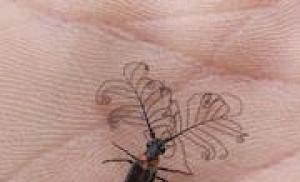Where the capybara is found. Animal capybara - the largest rodent
Capybara (lat. Hydrochoerus capybara) Is a semi-aquatic mammal, the largest of modern rodents. It is the only representative of the capybara family (lat. Hydrochoeridae). There is a dwarf variety Hydrochoerus isthmius, sometimes it is considered as a separate species (lesser capybara).
Capybara externally can be compared with large sizes... The body length of an adult can reach 1.0-1.35 m. The height at the withers is 0.5-0.6 m. The weight of males ranges from 34 to 63 kg. Females are slightly larger, can weigh up to 65.5 kg.

flickr / cdallacosta
It is an outwardly phlegmatic herbivorous rodent of heavy constitution. Have capybaras wide, blunt muzzle. The head is large with short, rounded ears. Highly set eyes are comparatively small in size. There are 20 teeth, and cheek teeth grow all their life. The capybara has rather short limbs. There are four toes on the front legs and three on the hind legs. There is practically no tail. On the body - long coarse hair without undercoat.

The capybara lives in Central and South America, meeting off the coast of warm water bodies of Argentina, Brazil, Venezuela, Guyana, Colombia, Paraguay, Peru, Uruguay, French Guiana. The factors limiting the spread of this rodent include the temperature of the water and air.

flickr / cdallacosta
Capybara prefers low-lying areas near rivers, lakes, swamps. Often he chooses a cultivated area, having the habit of eating cereals, melons and gourds, sugar cane. It also feeds on coastal and aquatic plants, tree bark, and wild grasses.

The semi-aquatic animal spends most of its time on the ground, and in case of danger it always tries to hide in the water. Taking refuge among aquatic plants, capybara leaves only the nostrils visible above the water surface. It does not move more than 500-1000 meters from the reservoir.

Shows activity in the morning and evening, sleeps at night, and rests during the day from the heat. In the area where capybaras can disturb people with their activities, it begins to lead night image life. When lying down, capybaras settle directly on the ground, they do not equip holes and nests.

These mammals live mainly in groups of 10 to 20 individuals. The group consists of a dominant male, several males, females and calves. But about 5-10 percent of individuals (mostly males) live alone. This happens when the dominant male drives out a competitor from the herd. A group of animals can occupy an area of up to 10 hectares, capybaras mark their plots, and a conflict between a group of its permanent inhabitants and aliens may arise.

Communication occurs through whistles, clicking sounds and sounds similar to barking. The smells of the secretion of the olfactory gland are also used. In males, it is on the muzzle. During the mating season, males mark plants with secretions and attract females. The mating season usually occurs at the start of the rainy season in spring and autumn.

Although capybaras can produce offspring throughout the year. Pregnancy lasts approximately 150 days. From 2 to 8 cubs are born. Newborn animals have hair, teeth, eyes open, weight about 1.5 kg. Milk feeding takes 3-4 months. Each female can produce droppings one to three times a year. Sexual maturity occurs at the age of 15-18 months.

The life span of animals is 9-10 years, in captivity they can live up to 12 years. Capybaras have long been domesticated and are kept as pets in some families. In Venezuela, animals are raised on farms and fed for meat. Capybara meat vaguely resembles pork.
An unusual pet for our country is the capybara. This is a kind of guinea pig, only quite large in size. Despite the fact that animals are accustomed to living in natural environment, the capybara also feels great at home, gladly makes contact with a person. A huge rodent native to the American continent, the natives called him "the lord of the grass" - for his insatiable appetite. What are the features of its content?
Appearance
"Capybara" - this is also the name of this rodent. He really resembles guinea pigs, only much larger in size and does not have such a variety of colors.
- The weight of an adult male can reach 63 kg, of a female - 65.
- Growth up to 60 cm, body length up to 1.5 m.
- The body is covered with long fur (no undercoat), which perfectly repels moisture.
- The upper part of the body is brown to grayish, and the lower part is yellowish brown.
- On the front legs - 4 toes with membranes, on the hind legs - 3.

They swim well, because it is very hot in their homeland, so it's better to spend sultry days in the water. They have fine strong teeth, similar to those of a rabbit. Most of the time they are in the water, this is the little that is very important to them. Even their ears, eyes and nostrils are positioned so that they can swim for as long as possible.
Living in natural conditions
The large size does not always help rodents survive in the natural environment. What dangers await a capybara? The video, available on various sites, will help reveal the secret - after all, these unusual animals are of interest to documentary filmmakers and nature lovers. The main natural enemy is the caiman. He is able to devour even an adult. Anacondas, leopards, and birds of prey also pose a threat.
Males have a special gland on their noses. that allows them to mark territory. Usually peaceful, these animals can fight if someone invades their territory. However, in dry season accumulate in huge flocks, together looking for water and food.
 Small birds sit on their backs to better see the approach of enemies. Their cry warns unwary rodents of danger. Capybaras are very run fast- quite capable of catching up with ponies. But most of all they like to stand up to their ears in the river. These animals do not build their own homes - all year round live under open air, tirelessly eating grass. For this, they wake up even in the middle of the night, if during the day someone prevented them from eating.
Small birds sit on their backs to better see the approach of enemies. Their cry warns unwary rodents of danger. Capybaras are very run fast- quite capable of catching up with ponies. But most of all they like to stand up to their ears in the river. These animals do not build their own homes - all year round live under open air, tirelessly eating grass. For this, they wake up even in the middle of the night, if during the day someone prevented them from eating.
Usually the family has up to 20 individuals... These are females and cubs, the head of the clan is the only male. In nature, they get along well with birds, ungulates, snakes. In fact, this indicates a weak instinct for self-preservation. But it makes an unusual rodent the kindest pet. He peacefully coexists with any other beast.
Reproduction
Like all rodents, they are able to reproduce quickly. Mating can take place 2 times a year, pregnancy lasts about six months. There are usually 5–7 cubs in a litter, they already have teeth and hair, they are immediately able to see. The weight of the babies is 1.5 kg. After a couple of weeks, babies begin to swim. Babysitting becomes the responsibility of the whole group. Very soon, the cubs begin to eat grass, but they do not refuse mother's milk until 4 months. Capybaras mature in a year and a half, reaching 2/3 of their weight. Grown up males can be driven out of the pack by the leader as potential competitors.




Price
Seeing such a cute pet, many wonder how much it might cost unusual rodent? Walking with such a pet will attract everyone's attention. In addition, communication with a kind bumpkin cheers up - scientists have long proven that having pets helps to resist stress and illness. Surprisingly, sometimes you come across an announcement that extra animals are given away for free. But this is rare. In general, a giant pig can cost from 50 to 150 thousand rubles. depending on the region.
For Russia, this is still a great rarity. In addition, it requires special conditions for keeping - a pool, a heated winter aviary (after all, animals are accustomed to a tropical climate).
 What does a capybara like to eat? The basis of the diet should be greens: grass, hay, vegetables and fruits... But you can give food for rodents and cats. Capybaras are smart enough, they quickly remember the place of feeding.
What does a capybara like to eat? The basis of the diet should be greens: grass, hay, vegetables and fruits... But you can give food for rodents and cats. Capybaras are smart enough, they quickly remember the place of feeding.
Calm disposition allows you to take them for a walk - they quickly get used to walking on a leash. They react well to guests, do not show aggression. In times of excitement, they bark like dogs. But this can only happen if the animal senses a threat to life. Good-natured giants can easily coexist with cats, birds, dogs.
About capybaras.
Capybara is the most large rodent living on planet earth. Another name for this animal is the capybara, because the capybara spends a significant part of its existence in water.

It is possible to translate the name of the animal from the language of the Guarani Indians as the lord or lord of herbs.
The length of the largest rodent can reach 1.5 meters, the height is 50-60 centimeters, and the weight of large individuals can reach 65 kilograms. The females of this animal are much larger than the males.

In the distant past, capybaras were much larger than they are now. Then their sizes were comparable to big bear grizzly. This fact was established through excavations and fossil studies.

The hind legs of a capybara have three toes, but the front legs have four toes both there and there, with membranes, as befits a waterfowl.

Capybara lives mainly in South America, near reservoirs with fresh water where it is quite warm. Animals live up to 12 years.

The rodent swims and dives perfectly, under water it can spend enough long time... The head of the capybara looks a bit like the head of a hippopotamus. The eyes, ears and nostrils are positioned on the top of the head, which allows you to swim freely and avoid water getting into your ears, eyes and nose.

Capybaras live in small groups, about 20 individuals each. All females look after all cubs. The group has one main male and several main females.

Capybaras are quite vulnerable. They have enemies both on land (jaguar, wild dogs, vultures) and in water (anacondas, caimans). It is very easy to scare them. In case of fright, the capybara immediately rushes into the water and hides or in the thickets.

300 years ago, capybaras were considered fish because they were often seen in the water. Therefore, the meat of these animals could be consumed in fasting.

Capybaras lead a measured lifestyle. Sleep all night and several hours during the day. The rest of the time is spent on feeding. Despite the fact that capybaras spend a lot of time in the water, they are herbivores and do not fish. But in zoos, they calmly eat fish.
Animals are not very clean, to the extent that they eat their own excrement.

The tail of the animal is very poorly expressed, it is considered rudimentary and practically does not perform any functions.

Rodents can breed all year round. Calving lasts, on average, five months. The female can give birth to 4 to 8 cubs. Newborn capybaras weigh about 1.5 kilograms, and immediately after birth they can stand on their feet and even walk.

A capybara can make a wide range of sounds: whistling, rumbling, clicking, and even a sound that looks like a dog barking. In male capybaras, the pineal olfactory gland is located on the muzzle. Females don't have one.

Six animals are monochromatic: brown, gray or yellowish. Sometimes there may be small spots on the face or sacrum.

In many areas South America the capybara is kept as a pet. She has a calm personality and quickly gets used to people. There are even farms where capybaras are bred. Their meat is eaten.
This beast is the only one in its family.
Caplin Rose is the most famous capybara in the world. A photo of an animal living in Texas constantly hits the front pages of magazines dedicated to the life of animals. The reason for this success lies in Caplin Rose. She is very sweet and funny, which captivates others at first sight.
In truth, these traits are common to all capybaras. However, unlike the Texas pet, wild animals are forced to take care of themselves and their offspring on their own. But this makes their life even more exciting and interesting for those around them.
A superficial view of the capybara
The capybara is a unique semi-aquatic herbivorous mammal from the capybara family. Its peculiarity is that only one single representative of the family has survived to this day. All the rest, alas, could not withstand climate change and died out hundreds of thousands of years ago.
Also, the capybara is notable for the fact that it is the largest representative of the order of rodents that live on our planet. So, some individuals of this species are able to grow up to 1.2, or even 1.5 m in length, which is quite comparable with the growth of a small person. And this is not all that this amazing beast can boast of. But let's talk about everything in order.

Beast from the tropics
The capybara is a rodent found only in Central and South America. This is their historical homeland. Only at the end of the 20th century, animals began to be actively exported outside these lands in order to form new colonies. For the most part, it was for the farmers who saw the financial benefits of breeding giant rodents.
In nature, the capybara lives near rivers and lakes, since it cannot survive without water. She tries to avoid open space, so she prefers to settle under cover. rainforest... However, the rodent does not stay in one place for a long time - it constantly migrates along the beloved reservoir.

Appearance
The capybara is an animal that is impressive for a rodent. So, adults on average grow up to 1.2 m in length. Moreover, their weight ranges from 40-60 kilograms. It is curious that females are larger than males and can easily surpass them in brute strength.
At first glance, the capybara is somewhat reminiscent of a guinea pig, only painfully fed up. Small plump legs look rather awkward against the background of a massive body. The head of the animal is oval, with a blunt muzzle at the end. The eyes are set wide, which allows the capybara to see the area well.
The coat is harsh and can change its length depending on the season. So, on hot days, the rodent molts, and with the onset of the rainy season, it again acquires a fur coat. In terms of color, most capybaras are brown or dark gray in color. However, sometimes there are individuals whose wool shimmers with a copper or even red tint.

What does a capybara eat?
The capybara is a herbivore. The basis of her diet is young grass, berries, roots and aquatic plants... By the way, the latter are the greatest delicacy for a capybara. In particular, this is why capybaras love to settle near water so much. After all, it is there that they can enjoy a lot of fresh food.
It also happens that a herd of capybaras can ruin a farmer's garden. But they do this not out of malice, but because a person is getting closer and closer to their lands. But most people do not understand this. Seeing the disorder in their field, they always go to take revenge on would-be pests. And then the poor rodents risk being left without a good half of their brood.

Unquenchable love for water
As mentioned earlier, the capybara is a beast that loves water. Therefore, it is not surprising that he spends most of his time near the reservoir. Here he rests, gets food, frolics and even hides from enemies. Fortunately, evolution has taken care of them, and capybaras feel very comfortable in such an environment.
So, at the end of their legs there are special membranes. They allow capybaras to develop great speed underwater. Their lungs will intervene with a large supply of oxygen, so that the capybaras can hold out at a depth for several minutes. And high-set eyes allow animals to observe from under the water, without giving away their location to enemies.

Habits and hierarchy within the pack
The capybara is a herd animal. Often these rodents are united in small groups of 10-15 individuals. But it also happens that animals establish much larger colonies. This occurs during periods of drought, when most shallow water sources dry up. Then the capybaras have to crowd around those reservoirs that are somehow capable of feeding them.
Such a neighborhood often leads to conflict situations... After all, male capybaras jealously guard their family. Therefore, inside large colonies there are conditional boundaries dividing the flocks into separate social cells. And so that everyone knows their place, the controlled area is designated by secretions from the scent glands.
Each group is headed by a male leader. His orders and decisions are "non-negotiable," especially from other males. He has the right to freely choose females for mating, which guarantees him the continuation of the genus. The rest have to, otherwise they may be completely expelled from the herd.

Mating season
Capybaras do not have a specific cycle in which they mate. It all depends on how long ago the females gave birth to offspring. Therefore, as soon as the body of the ladies is ready for a new conception, the mating season begins in rodents. Really, heatwave or the absence of a constant food source may delay this process for a longer period.
The “first night's right” always remains with the leader of the pack. Moreover, he can mate with all females in his group. But since there are often a lot of them, other gentlemen also get an unoccupied partner. It is curious that the very process of fusion in capybaras occurs only in water. Therefore, if there is no decent reservoir nearby, then the males will not have "intima" either.

Natural enemies
The main enemy of capybaras are jaguars and wild dogs... They constantly chase poor rodents, as they are easy prey. Also, small capybaras should be wary of the urubu vultures and anacondas that live in the hot tropics. And, of course, alligators pose a great threat to these animals.

Home capybara
The meat of these animals has long been considered a delicacy among the natives. And at the end of the last century, local farmers also tried to breed rodents. And many of them liked the capybara. At home, the animal grew to an unprecedented size, which promised a good profit from the sale of meat.
In addition, breeding capybaras is several times cheaper than caring for cows or goats. First, rodents eat much less grass, which is beneficial for farmers. And secondly, abandoned swamps or backwaters can be used instead of pastures. That is, breeding capybaras has many advantages that completely cover all the disadvantages.
Far across the ocean, in hot Venezuela, an amazing animal lives. It swims like an anaconda, toothy, like, with shiny otter hair. Who can guess what kind of animal it is? Correct answer - capybara, but in Russia, Ukraine and Belarus, probably few have heard of such an exotic creation.
The capybara is also called the capybara, and what is most interesting, many people settle this rodent at their place. Here's an unusual alternative to hamsters, rats and guinea pigs. True, keeping such an animal in an apartment will be very problematic, because capybara weight about 65 kg, and the height is the same as that of an adult sheep. She just loves water, and her whole body is covered with a special water-repellent fur. And here are a couple of other features of the capybara: long front teeth, like a rabbit, and the ability to bark like a dog.
Scientists consider the capybara to be the largest rodent. Her whole life is closely connected with various bodies of water. The banks of rivers, swamps, lakes are its usual habitat. These animals are surprisingly dexterous swimmers and love to spend a huge amount of time in the water. Despite being quite large for pet the size of the capybara (body length 1.5 m) and rather big weight, many lovers of unusual animals still risked settling this rodent. Many find in him a resemblance to guinea pig thanks to a cute little face, small, neat ears and a movable nose.
"Capybara" is a name coined by the Indians of South America. Translated from their language, it means "the owner of the grass." But scientists, when they stumbled upon this mammal, could not find a name for it, because they had never seen anyone like it. As a result of long deliberation, the researchers named him the capybara and took him to the rodent detachment.
What does a capybara look like?
Anyone who is closely acquainted with the capybara considers it to be a very cute animal. Its main advantage is a small tail, because often it is this part of the body that kills all a person's love for rodents, such as rats and mice. The pensive, complacent muzzle of the capybara also evokes sympathy. The body of the animal is dense, well-fed, the head is massive. The hind legs are slightly shorter than the front ones, and it seems as if the capybara is constantly doing squats. The front legs of the capybara have four toes, and the hind legs have only three. Between the fingers there are membranes, thanks to which the animal can swim, and it also has rather sharp claws, so climbing a tree is not a problem for a capybara. The real pride of a capybara is a thick, long brown coat.

The eyes, nose and ears of the capybara are set high, and therefore, when it bathes in the reservoir, the senses are not submerged under the water. So the rodent can calmly wait out the heat in comfortable conditions.
What a capybara eats in nature and how to feed it at home
The main dishes on the capybara menu are seaweed and grass. This animal never starves or fights with others for food, because it is full not only on the ground, but also under water. This is one of the factors due to which the animals, although they have become much smaller than their ancient ancestors, still survived to this day. Capybara is a happy animal, because it has practically no enemies. The main threat their quiet life on land - jaguars, in the water - caimans and anacondas.
How and where does a capybara live in nature
Capybara is a herd animal... They form groups headed by a male and some females. The rest of the males and a huge number of cubs are "subordinates". Capybaras are very peaceful animals, so there are practically no quarrels in their family. Rights and responsibilities are clearly defined, so that the environment is usually calm. The whole company of the animals roam the shores of reservoirs, from time to time stopping to rest. Capybaras sleep not in burrows, but in an open place. During the day they look for water or dense thickets, to hide from the sun, but the evening and morning coolness returns energy and activity to rodents.

Baby capybaras
A capybara usually gives birth to four cubs. Babies are independent from the very beginning, although they continue to feed on mother's milk for another sixteen weeks. From the moment of birth, the capybara cubs already have wool, their eyes can see well and they can calmly follow the herd. The female capybaras are excellent mothers. They are very affectionate not only for their own babies, but for all the cubs in the herd.
How many capybaras live in the wild and at home
The life span of capybaras, like other rodents, is quite long. V natural environment habitat they live for about 10 years, and in artificial conditions- 12. A phlegmatic disposition and measured life help them to live to such a respectable age. People could learn from them. Capybara is a peaceful animal, she does not like to fight, and if she notices danger, she immediately runs away and hides. As soon as the danger passes, it grazes again calmly.
How the capybara was hunted and then tamed
For many years, the enemies of the capybara were only forest and aquatic predators... But with the beginning of the colonization of America, people appreciated the warm fur and delicious meat of animals, and opened a real hunt for them. In addition, the capybara was even considered for a long time, and the colonists with redoubled zeal destroyed the peace-loving animals. Fortunately, people changed their minds in time. It was decided to build special farms and domesticate the capybara.

The conditions on the capybara farms were pleasant. Still: there is plenty of food, spacious reservoirs in which you can swim and dive freely, and even the absence of the usual predators. Thanks to these factors, the capybaras multiplied rapidly, not knowing about the sad fate awaiting them.
Pets are capybaras. Care rules
Many people, having seen a capybara once, or even having read about it on the Internet or in a magazine, dream of having such an animal. And that's not a bad idea at all! Really, capybara can bark like a dog, but does not growl and will never bite your guests. She quickly masters, and becomes almost a member of the family. This animal shares its calm energy with all the inhabitants of the house, its behavior suppresses aggression, soothes overwrought nerves and tunes only good mood... Capybaras can get along well even with dogs and cats.
It is strictly forbidden to plant a capybara in a cage. These freedom-loving animals simply cannot survive in it. Yes, and rather big sizes require appropriate space. Capybaras also need a specific climate, because they are used to living in warmth, so something like a greenhouse combined with an indoor pool will do.

Feeding the capybara is not difficult. Vegetables, fruits, fresh hay - this is their favorite diet. Capybara will not refuse canned food or granules for rodents. The animal will remember the place where the feeder is located very quickly.
The capybara can be walked on a leash like a dog, or you can let her run free. These animals are ideal swimming friends, and even teachers who are my own example will demonstrate correct technique diving.
And finally, good news for apartment residents who want to have such a exotic pet: exists dwarf capybara... These animals are similar in size to rabbits (), but they are much more active.













